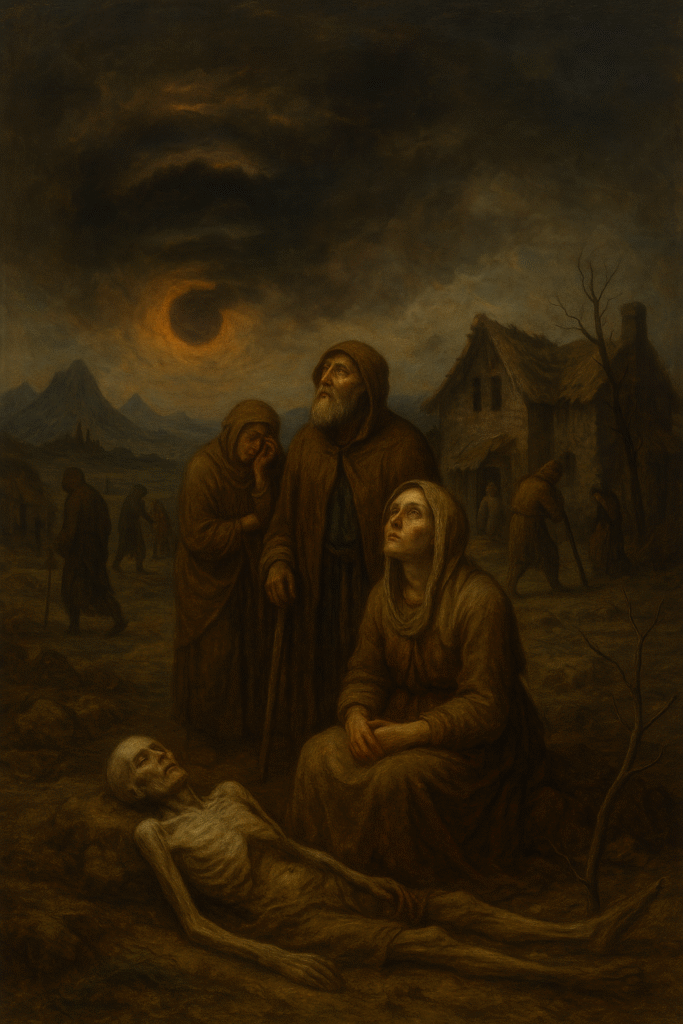The year 536 AD is often referred to as the Year Without a Summer due to drastic climate changes that impacted civilizations across the globe. Historical records suggest that a series of volcanic eruptions, potentially including one on Mount Vesuvius, led to a dramatic increase in aerosols in the atmosphere, resulting in lower temperatures and a lingering haze, famously dubbed “the day the sun went dark.” This climatic anomaly not only disrupted weather patterns but also had profound implications for agriculture, migration, and culture that would resonate for decades, if not centuries.
Detailed Analysis of Historical Account and Scientific Research
Scientific Explanations Behind the 536 AD Events
Volcanic eruptions are widely accepted as the primary cause of the 536 AD climate event. Historical texts from Procopius of Caesarea, a Byzantine historian, document the chilling conditions, indicating that the sun was obscured and temperatures dropped significantly. Scientists have corroborated these historical accounts with paleoclimate data and ice core samples from Greenland, which reveal a significant spike in volcanic sulfate concentrations around 536 AD. This data points to two effective volcanic eruptions, one from an unknown volcano likely located in Central Asia, suggesting that the eruptions led to a ‘volcanic winter’ scenario, where sunlight was reduced significantly, leading to a drop in temperatures worldwide.
Additionally, dendrochronology, the study of tree rings, indicates chaotic years where tree growth slowed, correlating with cold temperatures. For instance, studies conducted by researchers such as Mann et al. show that the temperature anomalies observed in 536 AD are echoed in broader climatic trends of the Medieval Warm Period (MWP) that follows. The cumulative climatic effects across multiple years exacerbated challenges in food production and agricultural sustainability.
Ripple Effects on Agriculture, Economy, and Migration
The consequences of the 536 AD climate event manifested dramatically in agricultural yields and broader economic structures. As temperatures fell significantly, crop harvests were deeply affected. Research indicates that major civilizations, including the Byzantine Empire and several Chinese dynasties, witnessed agricultural failures. In regions such as Europe, barley and wheat yields declined dramatically, leading to widespread food shortages. Procopius mentioned starvation that made people sell their children for food, which provides a harrowing account of the sociocultural impacts of these conditions.
Furthermore, the decline in agricultural output led to societal instabilities, as economic classes fractured under pressure. As towns emptied in search of better conditions, increased migration ensued, with populations moving from less fertile areas to more promising lands. Historical records also show this was a period when the Huns and other nomadic tribes began to migrate toward Europe due to their own climatic challenges, leading to heightened conflicts and cultural intermingling. In stark detail, the social implications of these migrations fueled what historians later viewed as the foundation for the Fall of the Western Roman Empire.
Impacts on Specific Regions and Civilizations
Byzantine Empire
In the heart of the Byzantine Empire, not only did the agricultural failures yield famine, but they also created sociopolitical instability. Emperor Justinian I faced revolts that historians commonly interpret as spurred on by food scarcity. Additionally, the Byzantine Empire’s military dependencies fluctuated based on the availability of resources; without sustenance, troop effectiveness diminished, thus leading to a weakening of Western borders and the eventual loss of Roman territories.
Europe
In Northern Europe, the darkened skies and poor conditions contributed to a period of renewed Viking exploration as populations sought more hospitable climates. The Anglo-Saxon Chronicles also note significant drops in crop yield during these years, laying the groundwork for significant population movements both northwards and southwards.
Asia
Conversely, in China, records indicate a similar trajectory. The History of Northern Dynasties chronicled famines fueled by poor agricultural conditions resulting from the temperature drop. The eventual disruption led to shifts in power dynamics as regions dependent on stable agricultural output struggled to maintain social order.
The Americas
Interestingly, soaring temperatures in some regions of the Americas caused drought conditions in Mesoamerica, suggesting that interconnected climate systems might have initiated agricultural shifts and migration patterns across multiple continents, thus reinforcing the idea of global climatic interdependence.
Long-Term Effects on Human History and Culture
The long-term ramifications of the climate event were multi-faceted. Culturally, philosophical movements began to flourish, with many communities seeking to understand the chaos wrought by nature. Increased emphasis was placed on religious interpretation of climatic events, such as attributing famines and misfortunes to divine displeasure—an attitude that would solidify in various cultures for centuries. The integration of celestial phenomena into cultural belief systems flourished during this time, reflecting a significant shift in how humanity perceived their relationship with nature.
The climate event also stimulated innovation as societies sought solutions to the agricultural crises. This period resulted in significant advancements in agriculture: the introduction of new crop species and farming techniques as civilizations juggled survival against the hardship of the climate. Crop diversification became an essential strategy in overcoming the erratic harvests that plagued various societies.
As societies were forced to migrate, cultural diffusion began to unfold, leading to increased cultural interactions and exchanges of ideas. This phenomenon could be observed across Europe, Asia, and even in the Americas, as populations adapted to new environments, enriching local customs and beliefs.
Summarizing Insights and Relevance to Current Issues
The events of 536 AD serve as a stark reminder of nature’s profound influence on human history. The consequences of the climate anomaly were not merely local; they resonated across continents, altering agricultural practices, prompting migration, and influencing societal structures for generations. As humanity grapples with contemporary climate change and its implications, understanding these historical precedents becomes crucial. The interconnectedness exposed through the weather patterns of 536 AD warns us against viewing climate challenges as isolated events. Thus, as stewards of the planet today, reflecting on history can guide us in preparing and adapting to the climate changes that await us.
This analysis suggests that climate events can dictate the course of civilizations in profound and irreversible ways. Through an interdisciplinary understanding that weaves together history, agricultural sciences, and cultural studies, one can appreciate how the shadows cast by climate events such as those in 536 AD have the potential to reshape our societal structures, philosophies, and cultures.
FAQ Section
What caused the climate event of 536 AD?
The climate event of 536 AD was largely caused by extensive volcanic eruptions which released aerosols into the atmosphere, leading to a marked decrease in temperatures and diminished sunlight.
How did the climate event affect agriculture?
Agricultural productivity suffered severe declines due to the cool temperatures and reduced sunlight, which led to widespread famines, particularly in Europe and Asia.
What were the long-term effects of the 536 AD climate event?
The 536 AD climate event resulted in population migrations, the weakening of empires, shifts in agricultural practices, and significant cultural and philosophical changes.
Can we draw parallels between the 536 AD event and modern climate change?
Yes, the 536 AD event illustrates how sudden climatic shifts can disrupt societies, leading to migration, food insecurity, and cultural change—issues we are currently facing with ongoing climate change.
How did communities respond to the agricultural challenges of 536 AD?
Communities developed new agricultural techniques, diversified crops, and engaged in migrations to seek more favorable growing conditions as a response to the environmental stress.


